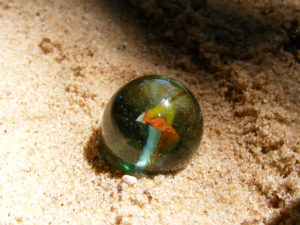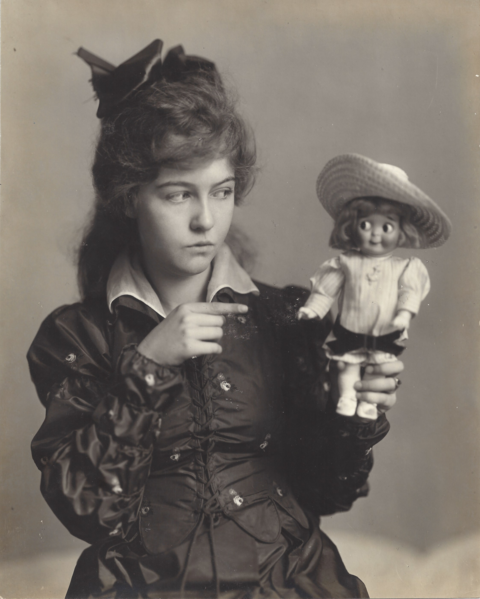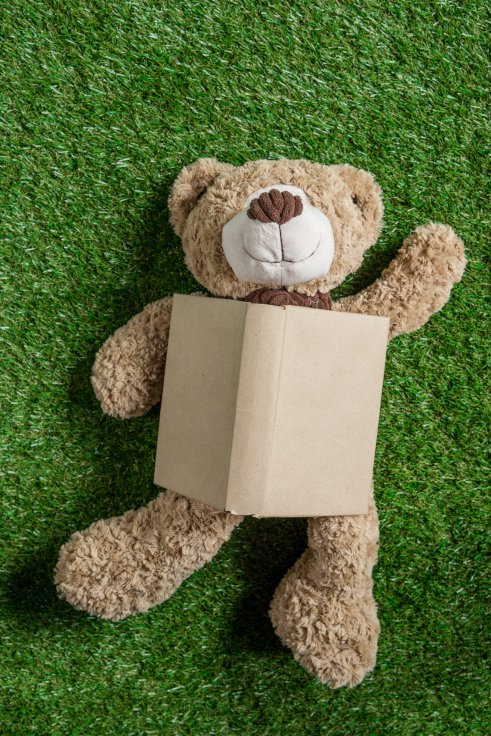Dorothy Gish with friend" (about 1920)
It is assumed that toys have been around since humans existed, made from the materials of the time. We may assume that the first ones were made of straw or wood, which would have been the first materials that could be shaped and worked. This was followed by stone and clay or clay-like materials and certainly also bones. With the refinement of the tools and the technical knowledge, the toys will have been refined continuously, that is how they developed, proven by the finds and the history that we can still reconstruct. These finds come, for example, from children's ditches of the Stone Age, where the named stone was worked into a tool, which in turn could work other materials, such as softer rock, wood, and bone. The Stone Age began about 2.5 million years ago. Among these archaeological finds was the recurring doll, so we may assume that this was the first toy, the replica of oneself or even animals, as can be seen in the historical wall paintings. Since the fire had not yet been invented as a controlled element, clay and loam sculptures will have weathered throughout millions of years; at that time, it could only be dried in the sun; naturally occurring fire, still mainly seen as a danger, will probably have been avoided.
Probably 1.8 million years ago, men began to use fire, but he was not yet able to light it himself; instead, natural fire from volcanoes or lightning was used and guarded. So they quickly learned to fire clay and loam, which can be deduced from the findings of food preparation and the physical development of man. By then at the latest, more durable figures and certainly more complex toys were created. Tires, drums, and horse figurines were found. In particular, finds from the advanced civilization of Egypt showed how detailed these toys looked, later also equipped with movable parts. Thus, many games have been handed down to us from the culture that is still played today, including board games and dice, certainly also many games that history has forgotten.
Almost as if it were yesterday, 32000 years ago, man learned how to create fire himself. Probably through try-and-error, he discovered that pyrite and so-called flint produced a spark when struck properly. Both minerals are hard, whereas flint is a little harder, but a class softer than semi-precious stones. In addition, it is piezoelectric, which means that when it is deformed, it can generate a voltage, i.e. a spark. So it was not until 8000 B.C. that the first metals were melted and certainly then metals found their way into toys.
Since not everyone was able to handle metals, it can be assumed that it was no longer a matter of the dexterity of the clan to produce quality toys, but that toys also acquired different values due to the material. This is probably how it started that different social classes or countries also had different toys at their disposal.

An orange and white toothpaste marble by Supportstorm
The first glass finds date back to 3500 BC, when was the first glass marble made?
Since until about 700 B.C. people probably only bartered, we have to assume that toys have also been traded since time immemorial. Around 200 B.C., the first mass productions took place on a large scale, which is substantiated in the history books by military evidence, but certainly also found its way into other everyday areas. At some point, toys could also be mass-produced and offered.
Since this blog is about educational toys, the question may arise as to when the first educational toy was created. This may have a lot to do with when a person was seen as a resource or was still allowed to develop out of play. What is meant by this? If, as has been documented, a child has to do full-time work by the time he or she is four years old, it can hardly be expected that creative play was possible for this individual. The play was a luxury for some children and young people. But it is conceivable that for many, their own drive to make or refine their own toys could already be seen as learning toys. Be it the doll's dress, an accessory, learning and developing out of play. The posts about building blocks give a few references to modern educational toys, including the experimental kits of our days.

